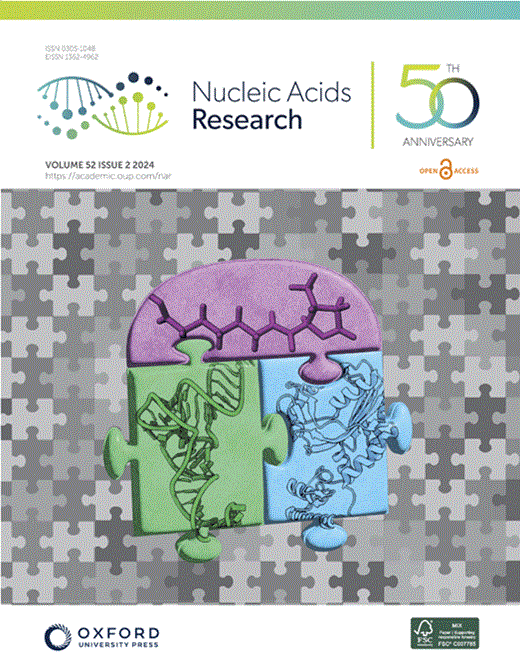CPV NSP9 的晶体结构和核酸结合模式:对 Reovirales 中病毒质的影响
IF 16.6
2区 生物学
Q1 BIOCHEMISTRY & MOLECULAR BIOLOGY
引用次数: 0
摘要
细胞质多角体病毒(CPVs)与Reovirales目其他成员一样,会产生病毒体,病毒体是病毒组装的枢纽,能使病毒免受宿主免疫的影响。我们的研究调查了 CPV 编码的核酸结合非结构蛋白 NSP9 在病毒体生物发生过程中的潜在作用。我们测定了 NSP9 核心(NSP9ΔC)的晶体结构,它显示出与植物再病毒的 P9-1 同源二聚体拓扑结构相似的二聚体组织。NSP9 的无序 C 端区域有利于寡聚化,但对核酸结合来说是不可或缺的。NSP9 可与单链和双链核酸牢固结合,无论其来源是 RNA 还是 DNA。突变研究进一步证实,NSP9 的二聚体形式对核酸结合至关重要,因为带正电荷的残基在同源二聚体化过程中形成了一条隧道。凝胶迁移试验揭示了一种独特的核酸结合模式,两种不同的复合物依次出现,取决于蛋白质的浓度。NSP9 和轮状病毒 NSP3 有着相似的凝胶迁移模式,再加上其结构与 P9-1 相似,这暗示了它在翻译调控或病毒基因组包装中的潜在作用,而这可能与病毒质体有关。这项研究增进了我们对病毒质生物发生和轮状病毒复制的了解,为潜在的抗病毒药物靶点提供了启示。本文章由计算机程序翻译,如有差异,请以英文原文为准。
Crystal structure and nucleic acid binding mode of CPV NSP9: implications for viroplasm in Reovirales
Cytoplasmic polyhedrosis viruses (CPVs), like other members of the order Reovirales, produce viroplasms, hubs of viral assembly that shield them from host immunity. Our study investigates the potential role of NSP9, a nucleic acid-binding non-structural protein encoded by CPVs, in viroplasm biogenesis. We determined the crystal structure of the NSP9 core (NSP9ΔC), which shows a dimeric organization topologically similar to the P9-1 homodimers of plant reoviruses. The disordered C-terminal region of NSP9 facilitates oligomerization but is dispensable for nucleic acid binding. NSP9 robustly binds to single- and double-stranded nucleic acids, regardless of RNA or DNA origin. Mutagenesis studies further confirmed that the dimeric form of NSP9 is critical for nucleic acid binding due to positively charged residues that form a tunnel during homodimerization. Gel migration assays reveal a unique nucleic acid binding pattern, with the sequential appearance of two distinct complexes dependent on protein concentration. The similar gel migration pattern shared by NSP9 and rotavirus NSP3, coupled with its structural resemblance to P9-1, hints at a potential role in translational regulation or viral genome packaging, which may be linked to viroplasm. This study advances our understanding of viroplasm biogenesis and Reovirales replication, providing insights into potential antiviral drug targets.
求助全文
通过发布文献求助,成功后即可免费获取论文全文。
去求助
来源期刊

Nucleic Acids Research
生物-生化与分子生物学
CiteScore
27.10
自引率
4.70%
发文量
1057
审稿时长
2 months
期刊介绍:
Nucleic Acids Research (NAR) is a scientific journal that publishes research on various aspects of nucleic acids and proteins involved in nucleic acid metabolism and interactions. It covers areas such as chemistry and synthetic biology, computational biology, gene regulation, chromatin and epigenetics, genome integrity, repair and replication, genomics, molecular biology, nucleic acid enzymes, RNA, and structural biology. The journal also includes a Survey and Summary section for brief reviews. Additionally, each year, the first issue is dedicated to biological databases, and an issue in July focuses on web-based software resources for the biological community. Nucleic Acids Research is indexed by several services including Abstracts on Hygiene and Communicable Diseases, Animal Breeding Abstracts, Agricultural Engineering Abstracts, Agbiotech News and Information, BIOSIS Previews, CAB Abstracts, and EMBASE.
 求助内容:
求助内容: 应助结果提醒方式:
应助结果提醒方式:


